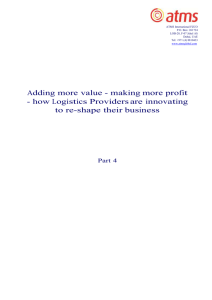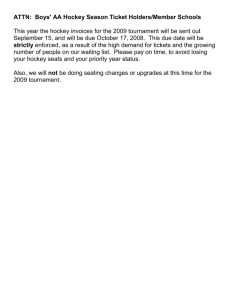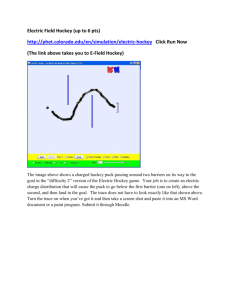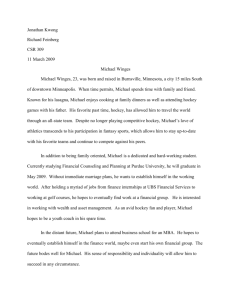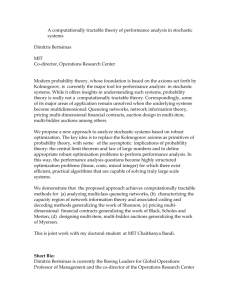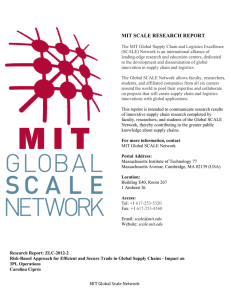MIT SCALE RESEARCH REPORT
advertisement
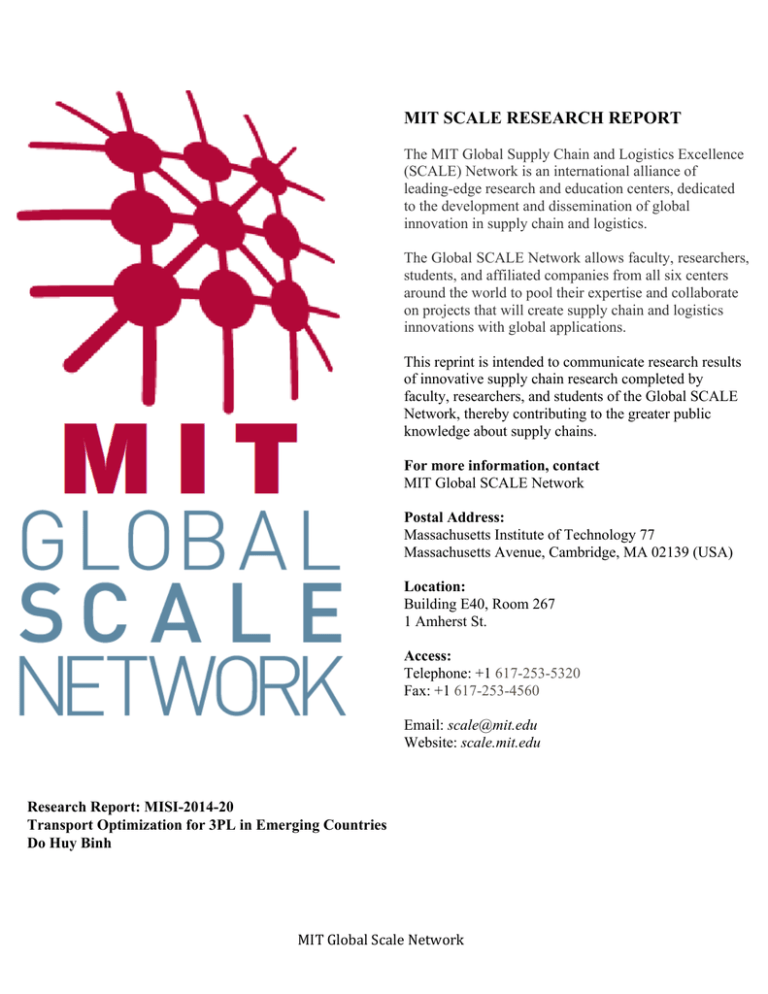
MIT SCALE RESEARCH REPORT The MIT Global Supply Chain and Logistics Excellence (SCALE) Network is an international alliance of leading-edge research and education centers, dedicated to the development and dissemination of global innovation in supply chain and logistics. The Global SCALE Network allows faculty, researchers, students, and affiliated companies from all six centers around the world to pool their expertise and collaborate on projects that will create supply chain and logistics innovations with global applications. This reprint is intended to communicate research results of innovative supply chain research completed by faculty, researchers, and students of the Global SCALE Network, thereby contributing to the greater public knowledge about supply chains. For more information, contact MIT Global SCALE Network Postal Address: Massachusetts Institute of Technology 77 Massachusetts Avenue, Cambridge, MA 02139 (USA) Location: Building E40, Room 267 1 Amherst St. Access: Telephone: +1 617-253-5320 Fax: +1 617-253-4560 Email: scale@mit.edu Website: scale.mit.edu Research Report: MISI-2014-20 Transport Optimization for 3PL in Emerging Countries Do Huy Binh MITGlobalScaleNetwork For full thesis version please contact: Professor Shardul Phadnis Director of Research MISI No. 2A, Persiaran Tebar Layar, Seksyen U8, Bukit Jelutong, Shah Alam, 40150 Selangor, Malaysia. Phone: +6 03 7841 4845 Email: sphadnis@misi.edu.my MITGlobalScaleNetwork Transport Optimization for 3PL in Emerging Countries by DO HUY BINH Submitted to the Malaysia Institute for Supply Chain Innovation On May 16, 2014 In partial fulfillment of the requirements for the Degree of Master of Science in Supply Chain Management Thesis Supervisor: Dr Albert Tan Title: Associate Professor EXECUTIVE SUMMARY Problem statement Transport optimization has become one of the most promising research area for more than 50 years. However, solving the problem in this area is more challenging due to higher uncertainty and complexity, especially in mega cities of emerging countries. In this research, we study one of the large 3PL in Vietnam, who are providing transportation service to CPG companies. The distributor channel that characterized with large and fluctuated order together with high uncertain and costly spot trucking market is the scope of our research. The current 3PL are facing with many challenges in providing its transportation service. First CPG Customer is one largest player in market with large distribution networks (figure 1), multi product with different characteristics, and high-low order volume with high volatility. Second, city logistics place many constraints such as truck weight and size limitation, operation time limitation, and congestions. Third, outsourced trucking vendors that 3PL depends on are highly unstable and costly. 1/5 Figure 1: Customer Distribution Network Methodology and Modelling The following methodology which we called “Hill Climbing Approach” is employed throughout our research. First, deeply explore the research literature domain on rich VRP include city logistics and Hockey Stick Effect factors is key step to refine the best approaches so far. To avoid “boiling the ocean”, we focus literature review mainly on applicable research which has been proven in reality. Second, the researched 3PL’s data analysis will be very critical step to define the right problem and proper objective function and its related constraints. Then, formulated problem in Linear Programming as mathematical function. The chosen formulation will be modelled into AIMMS software which is powerful optimization modelling software. Third, result of optimization will be benchmarked with current practices and expanded for broader horizon including time and service level which is one of most common factor in dealing with variability under city logistics and Hockey Stick Effect. Figure 1 below briefs our methodology. 2/5 Figure 2 : Research Methodology Summary of findings In the research we provide the solutions to complex rich VRP problem which prevail in emerging countries. By focusing on optimize the number of trips required, the VRP problem can be solved effectively with exact method through Mix Integer Programming. The objective has shift the model from VRP problem with mainly minimize the distance or transport cost to Generalized Assignment Problem (GAP) with mainly focus on minimizing number trips usage. In other words, there is more concentration on capacity utilization rather than distance. The reason for the objective is firstly limitation possibility of route consolidation to two drop points. Secondly, the solution also consider Hockey Stick Effect under city logistics constraints as another motivation to build suitable model adapt with both VRP and Hockey Stick Effect. Thirdly, it is important to note that higher outsourced transport cost is another driver for minimizing trip usage. Modelling results of 9 instances has produced very promising improvement in terms of trips minimization which consequently help 3PL reduce total cost and dependence on outsourced truck vendor. The average reduction in trip usage is 19% and average cost saving is 14%. Simultaneously, the truck utilization increase significantly to 82.7% in tonnage and 97.2% in cubic metric in compare with current 72.6% and 85.8% respectively. The summary of results and its performance benchmark with current situation are described in figure 3. On managerial perspective, the results will help 3PL 3/5 quickly reduce the dependency on outsourced truck vendors which are very costly and unstable. It also help transport planner shorten time in scheduling and planning daily. Mostly, the time for preparing and running model is around 30 minutes which is far shorter than current practice with more than two and half hours. Figure 3 : The Optimization Results To deal with Hockey Stick Effect, we also propose two solution approaches combining with optimization model which include increase service time to night delivery and reduce service level during peak period. For night delivery option, we can significantly reduce the required number truck usage which is most important indicator in coping with Hockey Stick Effect. The reduction is average 43% in compare with 19% of normal optimization option. Even though, the cost saving is not significantly different with pure optimized option, 3PL still find the solution as better way to reduce Hockey Stick Effect by buffering service time. For order service level relaxation option, the improvement is only 22% versus current case or 3% higher than normal optimization model case in terms of truck savings. 4/5 Figure 4 : The Benchmarking Results Conclusions The research aim to tackle the transport optimization problem under one of the large effects called Hockey Stick which prevail in developing countries’ supply chain. By choosing the right objective function and mixed integer programming with support of AIMMS software, the author has come up with promising results and significant savings for 3PL. In addition, an adaption of the model is applied to other solutions. By combining the optimized model with some extending in terms of service time and service level, we can leverage the optimized result to higher improvement which can help 3PL deal effectively with spike demand in end of period. In conclusion, by addressing the VRP under Hockey Stick Effect in emerging countries, the author has developed model that practically help improve transportation performance and theoretically contributed the empirical evidence to transportation optimization research area. 5/5
